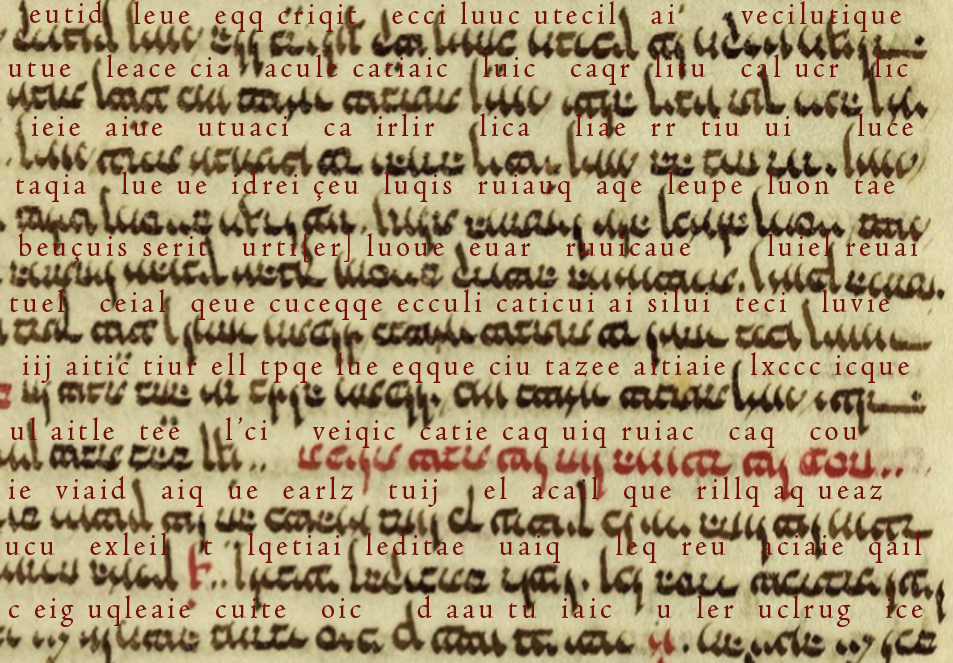Here’s a chunk of cryptic text that looks like Latin at first glance, early Latin, in a 13th-century script. To read it, you need to remember a few things about old-style script…
In the early medieval period, they wrote letters differently…
- “a” was written like two cees joined—”cc”,
- “t” was small and round like a “c”,
- “e” was sometimes written without a crossbar, and sometimes with a longer embellished crossbar,
- the stem of the “i” sometimes had a slight curve, similar to the rounded “t”,
- a common style of “r” had a long foot on the bottom (it almost looks like a square cee), and
- roman numerals with several ones in a row or words with two “i” chars at the end, usually added a descending tail to the last one so it looks like a “j”.
I won’t keep you in suspense any longer. Here’s the cryptic text with a rough transliteration:
The transliteration doesn’t have to be perfect to demonstrate that there’s something a bit weird about this text.
What language is it? It looks vaguely like early medieval Latin, but the common words aren’t there, and it’s somewhat more repetitive than one would expect.
Is it another language expressed with Latin characters?
I’ll let you think about it before I provide further information.
J.K. Petersen
© Copyright 2018 J.K. Petersen, All Rights Reserved


Sorry to rain on the parade, but this is definitely upside-down Hebrew.
Just at first glance I noticed the red text to be:
תפילת שבת של חול המועד של פסח…
Meaning: The payer of the Sabbath of the intermediate days of Passover…
Yes, it is. I expected someone who knew Hebrew would recognize it right away, but was hoping it might sit for a day or so before that happened. Most of use would recognize upside-down text in languages we know well.
You’re not raining on the parade, however. I think it was still worth posting because this is what I do with every new language and alphabet I investigate, to see if the VMS shapes, or the VMS text (which are two different issues) might in any way relate to inverse or mirrored text. If one could take a foreign script and assign values to the shapes and then transcribe it rotated or mirrored in some direction (especially if some characters that are ligatures then become single glyphs in a consistent way), then you end up with something that’s a half step away from a simple substitution code. It would still be easy to break, but it would be an interesting way to design a cipher if one extra step were then applied after transcribing it. It would also be interesting if the first step were to rotate each individual character 45° so the shapes take on different relationships to each other.
Thanks for participating. I considered waiting a half day or so to approve your comment, so others would have a chance to see it without a spoiler, but somehow that didn’t seem fair to you, so here it is. 🙂
I first saw this when I didn’t have much time and I admit it had me stumped. One of the things I planned on doing was flipping it around, mirroring etc to see if you had done some trickery. I found it suspicious that you had cut off the edges 😉 So I think I’d have recognized it there, but it looks like the Fox beat me to it.
It’s a good exercise though. If you flip Hebrew around, you get a new script nobody is familiar with. How do you parse it, which glyphs are different? These are familiar problems.
What I found interesting about Hebrew in particular, is that it ALMOST looks like Latin characters when it is flipped around. Not late-Medieval, the shapes are definitely more similar to early-Medieval scripts (with the double-cee form of “a” for example), but if you were to rewrite the upside-down script with a couple of the glyphs changed to different shapes so the Hebrew was less obvious, it would bear some resemblance to cipher-text.
Some of the Asian scripts take on interesting shapes when they are mirrored or rotated (I tried this with almost every alphabet on the planet). Not the Chinese scripts, they are easily recognized in any orientation, but some of the Malaysian scripts had some interesting properties when flipped around.